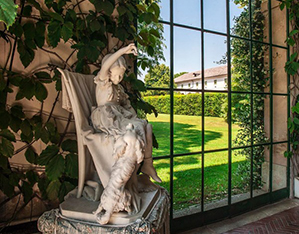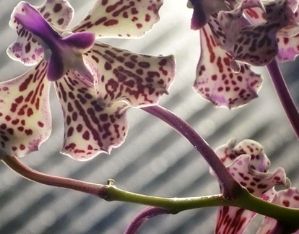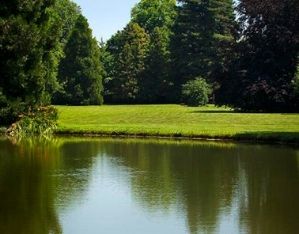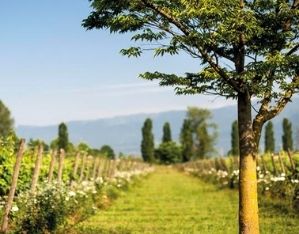This centuries-old rural complex boasts a truly lovely garden, one in which the essential shapes of a traditional Venetian manor house serve as the backdrop for a composition that reworks and enhances the gentle beauty of the place in a refined and artful way.
Once owned by the de Zorzi family, this site, not far from Sacile, was acquired by the patrician Brandolini-Rota Venetian family in 1780. In the 19th century, Count Guido established an estate here dedicated to winemaking. In the mid-19th century, the estate and its outbuildings were updated to what we see today. The park was bordered by a quadrilateral perimeter wall, with a romantically-inspired turret at each corner. Planting began in the early 20th century, in the Veneto-Friuli area tradition. The villa underwent renovations during the 20th century. In 1963, Count Brando and his wife, Cristiana Agnelli, commissioned English landscape architect Russell Page (1906-1985), the eminent Turin-based family’s trusted garden designer. Page transformed the garden into a romantically-inspired natural park, with some Russian touches at the owners’ behest, generally following 19th-century traditions that enhance the centrality of the house, located to the north, and bolster the compositional role of greenery. In just three years, Page managed to create a sober and elegant park, taking advantage of the garden’s location on a regular flat area almost a hectare in size. To enliven his composition, he inserted a series of groves, creating points of interest that alternate with water features and enhance the visual impact of this ensemble as it nestles in its surrounding rural environment.
Highlights

The Barchessa and the Statue
Fitting in with the pleasing and “informal” aspect of the rustic outbuildings, from the window inside the outhouse covered with green creepers you may make out a beautiful and realistic statue dating back to the mid-19th century, made by Swiss-Italian sculptor Vincenzo Vela, representing a little girl (identified as Countess Leopoldina d’Adda) playing with her little dog.

The Orchid Greenhouse
This specially-built “winter garden” was intended for tropical orchids purchased on many trips, which were the pride and joy of the owners and their gardeners: a thousand specimens of different genera arranged along a display wall that showcases both their variety and worth.

Ponds
The three contiguous spring-fed ponds, using the waters of a stream that flows through this vast area, are designed so the water is always in circulation and therefore never becomes stagnant. Enlivened by islets and water lilies, the ponds reflect the dwelling, capturing the colours of the vegetation and the sky and animating the entire composition, surrounded as it is by dense groves of conifers, deciduous trees and bamboo.

Winemaking
The clayey soils and warm, breezy summers make for some truly great reds. Meticulous work began in 1980 to safeguard the centuries-old Merlot Vistorta vines, along with planting new vineyards under organic management, which today produce a refined fruit with unique characteristics. Open to the public, the winemaking facilities that were once housed in the barchessa next to the Villa are now located in the sumptuous 18th-century Cordignano barchessa.
 Villa Brandolini D’Adda – Vistorta
Contacts
Villa Brandolini D’Adda – Vistorta
Contacts
 Villa Brandolini D’Adda – Vistorta
Opening times and prices
Villa Brandolini D’Adda – Vistorta
Opening times and prices
Opening hours
Open by reservation.
Pricing
Guided tour € 10,00
 Villa Brandolini D’Adda – Vistorta
How to get there
Villa Brandolini D’Adda – Vistorta
How to get there
Address
Via Vistorta, 82
33077, Sacile (PN)
Latitude: 45.9364962
Longitude: 12.471393
How to arrive by road
From the North: Take the A4 Torino-Trieste motorway towards Trieste. Continue on the A27 towards Belluno, then exit at Conegliano for the A28 towards Portogruaro. Continue on A28 Portogruaro – Conegliano/A28. Take the exit Sacile Ovest towards Sacile Ovest. Turn left at the junction and continue in the direction of Strada Vistorta for about 2.6 km. At the roundabout take the 1st exit and drive along Strada Vistorta until the arrival.
How to arrive by train
From Venice Central Station regional train to Udine, stop Conegliano.
Then take Bus n.153 Sacile – ITC Cornadella stop (29 stops, about 45 minutes).
Then continue on foot for about 2km until the arrival.
Additional directions
Venice Marco Polo Airport: 66 km
 Villa Brandolini D’Adda – Vistorta
Services/Accessibility
Villa Brandolini D’Adda – Vistorta
Services/Accessibility
Services
Pets are allowed.
There is parking for guests.
Possibility of tastings for groups of minimum 10 people, on request.
 Villa Brandolini D’Adda – Vistorta
Private events
Villa Brandolini D’Adda – Vistorta
Private events
The location hosts weddings and ceremonies.
 Villa Brandolini D’Adda – Vistorta
Itineraries
Villa Brandolini D’Adda – Vistorta
Itineraries
You could find the garden in these itineraries
 Favorite saving result
Favorite saving result
 Warning!
Warning!
You've have to sign up or sign in to add this element to your favorites.
